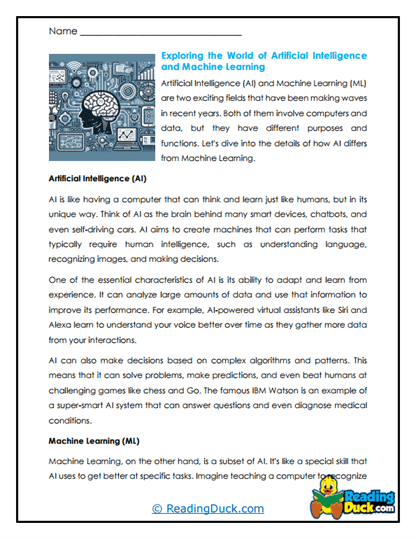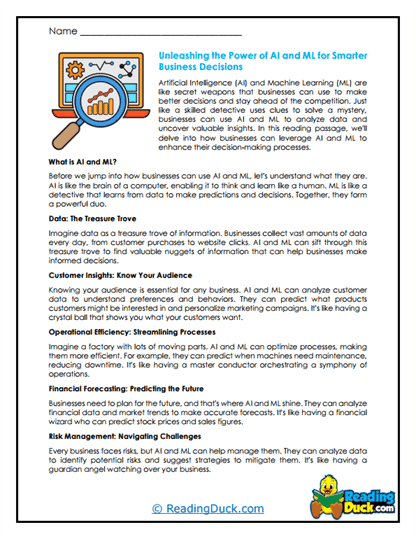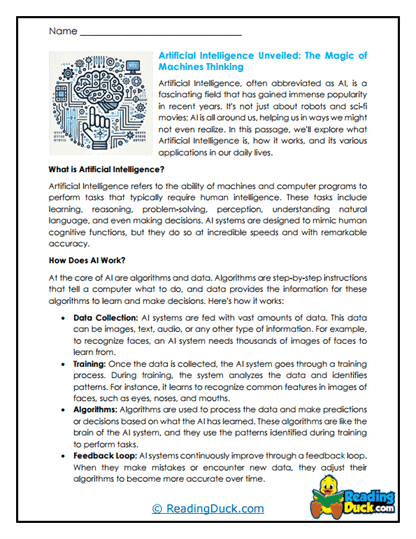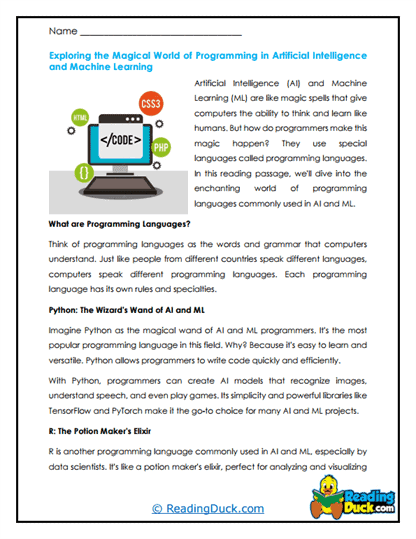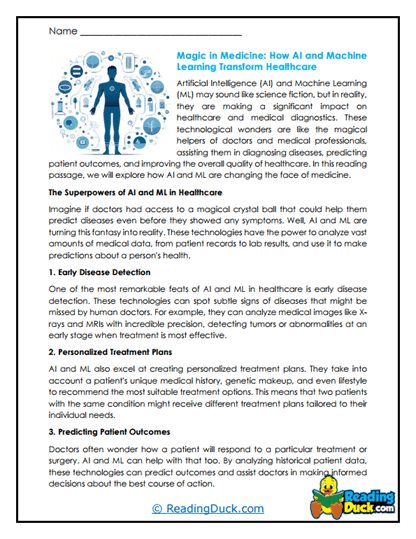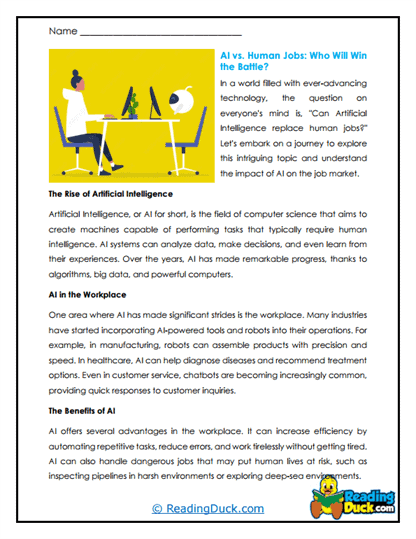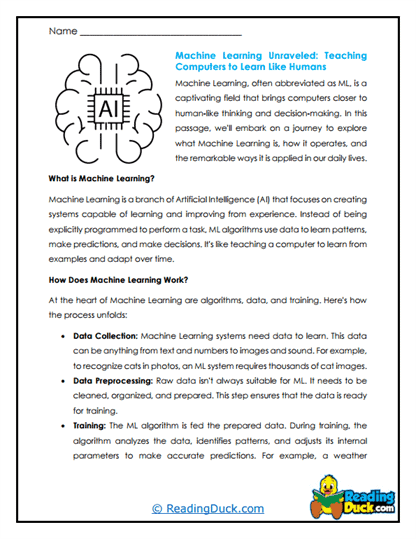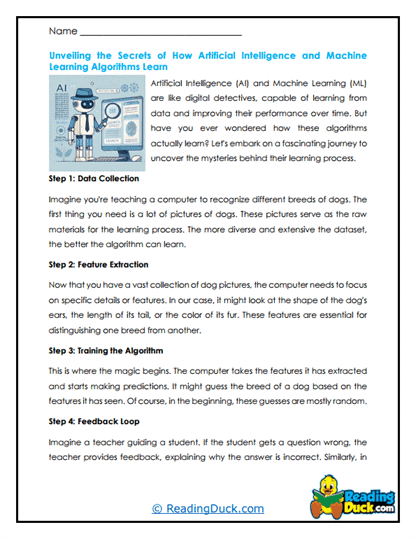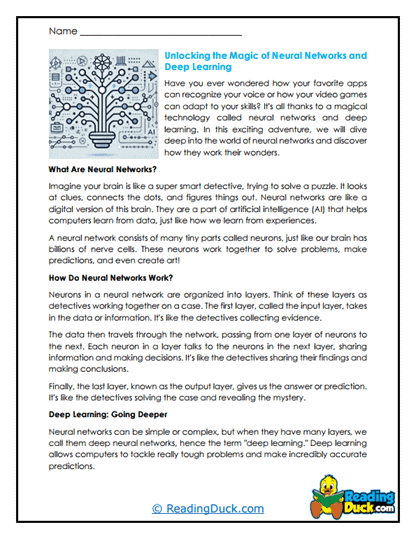Artificial Intelligence Worksheets
About Our Artificial Intelligence Worksheets
Our Artificial Intelligence (AI) Worksheets offer a comprehensive and engaging introduction to one of the most transformative technologies of our time. These worksheets are designed to help students understand the fundamental concepts and real-world applications of AI, from how it works to how it impacts our daily lives. Each worksheet set includes a reading passage paired with visually engaging and relevant imagery, as well as a variety of questions to assess comprehension and encourage critical thinking.
Each worksheet set features:
- Multiple Choice Questions: These questions test students' understanding of key concepts, ensuring they grasp the essential elements of AI.
- Short Answer Questions: These questions encourage students to express their understanding in their own words, promoting clarity of thought and deeper comprehension.
- Open-Ended Questions: These questions invite students to share their personal opinions, preferences, and reflections on the material, fostering a more meaningful connection with the topic.
These worksheets are not just tools for assessment; they are designed to foster a deeper connection with the material. An answer key is provided for each question sheet, and all worksheets are available in PDF format, making them easy to download, view electronically, and print out for classroom or home use.
Exploring the World of Artificial Intelligence: Understanding the Future of Technology
Artificial Intelligence (AI) is a branch of computer science focused on creating systems capable of performing tasks that typically require human intelligence. This includes problem-solving, learning, understanding language, recognizing patterns, and even making decisions. AI is rapidly becoming an integral part of our lives, from virtual assistants like Siri and Alexa to advanced robotics, self-driving cars, and even AI-driven medical diagnostics.
Key Concepts in AI
Understanding AI begins with grasping its core concepts. Our worksheets introduce students to the basics of AI, including:
- Machine Learning: A subset of AI where systems learn from data to improve their performance over time without being explicitly programmed for each task.
- Neural Networks: These are computing systems inspired by the human brain's structure and function, enabling machines to recognize patterns and make predictions.
- Natural Language Processing (NLP): This allows computers to understand, interpret, and generate human language, making interactions with AI more intuitive.
- Ethics in AI: With the growing influence of AI, ethical considerations are crucial. Students will explore the ethical implications of AI, including issues like privacy, bias, and the impact of automation on jobs.
Applications of Artificial Intelligence
AI is revolutionizing various industries and aspects of daily life. The worksheets delve into the diverse applications of AI, helping students see its broad impact:
- Healthcare: AI is transforming healthcare by enabling faster and more accurate diagnostics, personalized treatment plans, and even robotic surgeries.
- Finance: In finance, AI is used for fraud detection, risk management, algorithmic trading, and customer service automation.
- Transportation: Self-driving cars and drones are becoming a reality, thanks to AI, which helps them navigate, avoid obstacles, and make decisions on the road.
- Education: AI is also making its way into education, providing personalized learning experiences, grading automation, and even helping teachers develop customized lesson plans.
These real-world examples help students understand the tangible impact of AI, making the subject more relatable and inspiring them to think about potential careers in AI-related fields.
The Future of Artificial Intelligence
The future of AI holds exciting possibilities. The worksheets guide students through discussions on emerging trends and future applications of AI, such as:
- AI in Space Exploration: AI is being used to analyze vast amounts of data from space missions and to operate rovers on other planets.
- AI in Climate Change Mitigation: AI is being applied to predict environmental changes, optimize energy usage, and even develop new materials for sustainable living.
- General AI: Unlike narrow AI, which is designed for specific tasks, general AI would possess the ability to perform any intellectual task that a human can do. Students are encouraged to think critically about the implications of such advancements.
Creative Uses for These Worksheets
Incorporating Artificial Intelligence Worksheets into your curriculum or homeschool setup can significantly enhance students’ learning experiences and spark a lasting interest in this critical field. Here are some practical and creative ways to use these worksheets effectively:
1. Hands-On AI Projects Encourage students to explore basic AI concepts through hands-on projects. For example, after completing the worksheets, students can try creating simple AI models using free tools like Google’s Teachable Machine. This hands-on experience can solidify their understanding of the concepts and show how AI works in practice.
2. Cross-Curricular Connections Integrate the AI worksheets with other subjects to create a richer learning experience. For example:
- Mathematics: Discuss the role of algorithms in AI and how they are developed using mathematical concepts like statistics and probability.
- Ethics and Social Studies: Explore the ethical implications of AI, including privacy concerns, job displacement, and AI's role in surveillance.
- English Language Arts: Use AI’s impact on language and communication, such as chatbots and automated translation tools, as discussion points in language classes.
3. Group Discussions and Debates Use the open-ended questions as prompts for group discussions or debates. Topics could include the ethical challenges of AI, the future of work in an AI-driven economy, or the potential risks and benefits of AI in society. This will help students develop critical thinking skills and articulate their ideas clearly.
4. Virtual Field Trips Take advantage of online resources to give students a virtual tour of AI labs or companies that specialize in AI. For instance, students can watch virtual tours of tech companies that are leading the AI revolution, providing a real-world connection to the concepts they’ve studied.
5. Creative Writing Assignments Encourage students to imagine the future of AI and write a short story or essay about how they envision AI will shape the world in the coming years. This exercise allows students to think creatively while reinforcing their understanding of AI’s potential.
6. Guest Speakers and Workshops Invite guest speakers who work in AI-related fields to talk to your students, either in person or via video call. These could be data scientists, software developers, or ethicists specializing in AI. Students can prepare questions based on the worksheets, making the session more interactive and relevant.
7. Parent Involvement Encourage parents to engage with their children’s learning by discussing the AI worksheets at home. Parents can help students with AI-related projects or explore AI technologies together, such as experimenting with voice assistants or exploring AI-driven games.
8. Explore Emerging Technologies Use the AI Worksheets as a springboard to explore other emerging technologies covered in the Technology category, such as Blockchain, Autonomous Vehicles, or Quantum Computing. This can help students see the interconnectedness of different technological fields and how they drive innovation together.
9. Interactive Quizzes and Games Incorporate interactive quizzes or games to review the material covered in the worksheets. There are many online platforms where you can create custom quizzes or games that make learning about AI more fun and engaging.
10. Display Student Work Showcase students’ work related to AI, such as their essays, projects, or creative writing pieces, in a class display or virtual gallery. This not only motivates students to do their best work but also allows them to take pride in their achievements and learn from their peers.
By integrating these Artificial Intelligence Worksheets into your teaching strategy, you can create a dynamic and engaging learning environment that not only educates students about AI but also inspires them to think critically about its potential and its impact on the future. These worksheets are designed to be versatile and accessible, making them a valuable resource for educators aiming to prepare students for a world increasingly influenced by AI.
